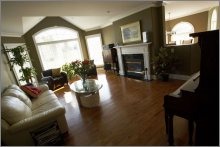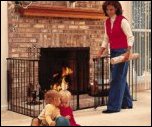|
|

|

The Top 10 Dangers of Fireplaces:
What Every Fireplace User Should Know
by www.SixWise.com Most people love the warmth and coziness of having a fireplace
in their home, so much so that fireplace sales rose to 3.2
million units in 2005, up 50 percent since 1998, according
to the Hearth, Patio and Barbecue Association.
|

About 55 percent of U.S. households have at least one
fireplace.
|
Over half of all U.S. homes (55 percent) have at least one
fireplace, and they're ranked as the third most desirable
feature that people look for when buying a new home, says
the National Association of Home Builders (outdoor porches
and upscale kitchens rank first and second).
But as you get ready to crank up your fireplace this winter
season, it's important to know that fireplaces can be dangerous
-- accounting for a large number of home fires and emergency
room visits every year. You can enjoy your fireplace while
keeping your family and your home safe by avoiding these 10
common fireplace dangers.
-
Not having your flue and chimney inspected each heating
season. If your flue or chimney are blocked by debris
or contain cracks or leaks, inadequate venting can occur,
and toxic fumes may seep into your home. Further, creosote,
a byproduct of burning wood, can build up on the chimney
flue and lead to a chimney fire. An inspection lets you
know that everything is in safe working order.
-
Forgetting to open the damper, or closing it too
soon. The fireplace damper should be opened before
lighting the fire, and kept open until all ashes are cool.
Closing a damper too soon, even if just the ashes are
warm, can allow poisonous gasses like carbon
monoxide to build up in your home.
-
Using charcoal in a fireplace. Charcoal should
never be used in a fireplace because it can lead to carbon
monoxide poisoning.
-
Not using a screen or glass enclosure. These
barriers are necessary to keep sparks, rolling logs and
embers from jumping out of the fireplace and starting
a fire.
|

Never burn charcoal in a fireplace -- it can release
poisonous carbon monoxide.
|
-
Allowing children or pets to get too close to the
fireplace (or carelessly getting too close yourself).
The glass barrier doors of a fireplace can reach over
400°F in only six minutes, and it takes 45 minutes
for the doors to cool down to a safe temperature after
the fire has been put out. Children may reach out to touch
the doors out of curiosity and suffer a serious burn.
"We urge the industry that makes and sells gas fireplaces
to warn consumers of this burn risk and to investigate
design changes to help protect children," says says
Amy Zierler, information specialist at Safe Kids Canada,
the national injury prevention program at The Hospital
for Sick Children.
An excellent option to consider when the fireplace is
in use is The
HearthGate™, a fireplace protection gate that
keeps kids and pets clear of dangerously hot indoor fireplaces.
-
Using gasoline, charcoal lighter fluid or other fuel
to light the fire. These substances release vapors
that could cause an explosion.
|
Enjoy Your Fireplace While
Keeping Your Kids and Pets Safe
 Fireplaces
are great for families, but they also present an added
risk of serious burns to your children and pets. But
with HearthGate Fireplace Protection Gate, the risk
is eliminated! Fireplaces
are great for families, but they also present an added
risk of serious burns to your children and pets. But
with HearthGate Fireplace Protection Gate, the risk
is eliminated!
- Base set fits a 6-feet wide by 2-feet deep hearth
- Five 24-inch wide and 28-inch high interlocking
sections (extensions available)
- Includes a single one-hand open gate that swings
in both directions
- Constructed of non-toxic strong tubular steel
... heat-resistant and easy to clean!
- Black finish blends beautifully with most home
interiors
Read
more about the HearthGate Barbecue and Fireplace Protection
Gate Now!
|
-
Burning plastic or other garbage in the fireplace.
Burning plastic materials like cups, wraps or plates,
or other trash, can release toxic gases into your home's
air.
-
Not cleaning your chimney regularly. This is
necessary to avoid the buildup of creosote that could
cause a fire. You should not use your fireplace if your
chimney is in need of a cleaning.
-
Using too much paper to build the fire. It's
OK to use paper to get your fire started, but using an
excessive amount can over-build the fire and ignite soot
in the chimney, causing a fire.
-
Hanging decorations from your mantel. If you
have decorations that hang down from your mantel over
your fireplace, it's possible for a spark to ignite them
and cause a fire. Make sure any decorations (i.e. Christmas
stockings, garland, etc.) have been removed before lighting
the fire.
Recommended Reading
Holiday
Hazards to Children, Pets and You
The
Top 10 Causes of Serious Burns to People and Pets in the Home
Sources
WTOL.com
October 30, 2006
IndyStar.com
October 7, 2006
Santa
Barbara County Fire Department
To get more information about this and other highly important topics, sign up for your free subscription to our weekly SixWise.com "Be Safe, Live Long & Prosper" e-newsletter.
With every issue of the free SixWise.com newsletter, you’ll get access to the insights, products, services, and more that can truly improve your well-being, peace of mind, and therefore your life!
|
|
|
|